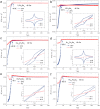Observation of superconductivity at 30~46 K in A(x)Fe₂Se₂(A = Li, Na, Ba, Sr, Ca, Yb, and Eu)
- PMID: 22645642
- PMCID: PMC3361284
- DOI: 10.1038/srep00426
Observation of superconductivity at 30~46 K in A(x)Fe₂Se₂(A = Li, Na, Ba, Sr, Ca, Yb, and Eu)
Abstract
New iron selenide superconductors by intercalating smaller-sized alkali metals (Li, Na) and alkaline earths using high-temperature routes have been pursued ever since the discovery of superconductivity at about 30 K in KFe₂Se₂, but all have failed so far. Here we demonstrate that a series of superconductors with enhanced T(c) = 30∼46 K can be obtained by intercalating metals, Li, Na, Ba, Sr, Ca, Yb, and Eu in between FeSe layers by the ammonothermal method at room temperature. Analysis on their powder X-ray diffraction patterns reveals that all the main phases can be indexed based on body-centered tetragonal lattices with a∼3.755-3.831 Å while c∼15.99-20.54 Å. Resistivities show the corresponding sharp transitions at 45 K and 39 K for NaFe₂Se₂ and Ba₀.₈Fe₂Se₂, respectively, confirming their bulk superconductivity. These findings provide a new starting point for studying the properties of these superconductors and an effective synthetic route for the exploration of new superconductors as well.
Figures

 ’ are due to unknown phase; (f) Nominal Ca0.5Fe2Se2; (g) Nominal Sr0.8Fe2Se2; (h) Nominal Ba0.8Fe2Se2; (i) Nominal EuFe2Se2; (j) Nominal Yb0.8Fe2Se2. Peaks marked by ‘*’ are due to residual β-FeSe.
’ are due to unknown phase; (f) Nominal Ca0.5Fe2Se2; (g) Nominal Sr0.8Fe2Se2; (h) Nominal Ba0.8Fe2Se2; (i) Nominal EuFe2Se2; (j) Nominal Yb0.8Fe2Se2. Peaks marked by ‘*’ are due to residual β-FeSe.



References
-
- Guo J. G. et al. Superconductivity in the iron selenide KxFe2Se2 (0≤x≤1.0). Phys. Rev. B 79, 180520(R) (2010).
-
- Wang A. F. et al. Superconductivity at 32 K in single-crystalline RbxFe2-ySe2. Phys. Rev. B 83, 060512(R) (2011).
-
- Li C. H., Shen B., Han F., Zhu X. Y. & Wen H. H. Transport properties and anisotropy of Rb1-xFe2-ySe2 single crystals. Phys. Rev. B 83, 184521 (2011).
-
- Krzton-Maziopa A. et al. Synthesis and crystal growth of Cs0.8(FeSe0.98)2: a new iron-based superconductor with Tc = 27 K. .J. Phys.: Condens. Matter 23, 052203 (2011). - PubMed
-
- Ying J. J. et al. Superconductivity and magnetic properties of single crystals of K0.75Fe1.66Se2 and Cs0.81Fe1.61Se2. Phys. Rev. B 83, 212502 (2011).
Publication types
MeSH terms
Substances
LinkOut - more resources
Full Text Sources
Other Literature Sources
Research Materials

